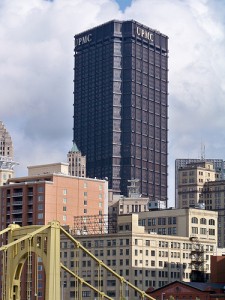Pittsburgh’s Tallest Building is Getting Greener

photo © Jon Dawson
The tallest structure between Chicago and Philadelphia is the 64-floor US Steel Tower in the heart of downtown Pittsburgh. The University of Pittsburgh Medical Center (UPMC) occupies 40 percent of the building, or roughly 900,000 square feet of office space, spread across 23 floors. As UPMC’s sustainability consultant, evolveEA, has been managing the global health enterprise’s efforts to systematically retrofit these spaces to LEED standards in a series of project phases. Between 2007 and 2013, more than half of UPMC’s occupied floors in the US Steel Tower have achieved at least basic LEED certification, with floors 8, 9, 12, 25 and 55 achieving LEED Silver. The remaining floors are currently under construction and are targeting LEED Silver certification, expected in 2014.
With the help of evolveEA, Winthrop Management and UPMC’s initiatives have included:
- Lighting: Installation of a Lutron light control system which allows for the same lighting power but 15-25% less energy use, and of occupancy sensors and daylight responsive controls which ensure the lights aren’t on when not in use. The new system also has extremely low mercury content as compared to previous light bulbs.
- Renewable energy: UPMC is purchasing 100 percent renewable or green electricity for the newest construction projects (on floors 5, 7, 8, 9, 11, 12, 14, 25, 31, 40, 41, 42, and 55).
- Efficient equipment: All new appliances and computers purchased for these floors is EnergyStar approved.
- Water efficiency: Installation of low-flow and dual flush toilets to reduce water consumption. Floors that have achieved Silver certification are 30 percent more efficient than comparable floors.
- Sustainable materials: At least 20 percent of the supplies purchased for the LEED-certified floors come from recycled materials. Adhesives, sealants, paints, flooring, composite wood and furniture contain little or no volatile organic compounds (VOCs). Plus, 75 percent of the construction waste on LEED-certified floors is diverted from landfills.
“Through the pursuit of LEED certification, there are a number of sustainability initiatives that UPMC has undertaken that are above and beyond conventional construction,” notes Marc Mondor, Principal at evolveEA. “As UPMC has full service leases at the Steel Tower, they don’t pay their electric and heating bills. Yet even though UPMC does not benefit from the financial savings of increased efficiency, these strategies are still pursued because it’s the right thing to do. These measures lessen environmental impact and create healthier environments for employees and visitors.”
Winthrop Management has also signed the US Steel Tower on to the Pittsburgh 2030 District challenge, a public-private partnership to create a high-performance and energy-efficient building district in downtown Pittsburgh by the year 2030. As part of this challenge, businesses are committing to reduce energy usage 50 percent over the next 17 years.
“UPMC and Winthrop’s work at the US Steel building exemplifies how a landlord and tenant can work together to achieve significant energy and water reductions, cost savings, and ongoing sustainability improvement,” added Mondor. “Through our work together, evolveEA has helped strategically target improvements that are resulting in substantial savings for both Winthrop and UPMC.”
Learn more about evolveEA’s work with UPMC

